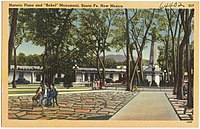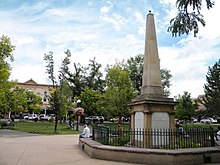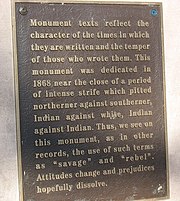
New Mexico is a state in the Southwestern region of the United States. It is one of the Mountain States of the southern Rocky Mountains, sharing the Four Corners region with Utah, Colorado, and Arizona. It also borders the state of Texas to the east and southeast, Oklahoma to the northeast, and shares an international border with the Mexican states of Chihuahua and Sonora to the south. New Mexico's largest city is Albuquerque, and its state capital is Santa Fe, the oldest state capital in the U.S., founded in 1610 as the government seat of Nuevo México in New Spain.

Albuquerque, also known as ABQ, Burque, the Duke City, and in the past 'the Q', is the most populous city in the U.S. state of New Mexico. Founded in 1706 as La Villa de Alburquerque by Santa Fe de Nuevo México governor Francisco Cuervo y Valdés, and named in honor of Francisco Fernández de la Cueva, 10th Duke of Alburquerque and Viceroy of New Spain, it served as an outpost on El Camino Real linking Mexico City to the northernmost territories of New Spain.

Española is a city primarily in Rio Arriba County, New Mexico, United States. A portion of the central and eastern section of the city is in Santa Fe County. Founded as a railroad village some distance from the old Indian town of San Juan de los Caballeros, it was named Española and officially incorporated in 1925. It has been called the first capital city in the United States. As of the 2020 census, the population was at 10,526. Española is within the Albuquerque–Santa Fe–Los Alamos combined statistical area.
Genízaros was the name for detribalized Native Americans (Indians) from the 17th to 19th century in the Spanish colony of New Mexico and neighboring regions of the American southwest. Genízaros were usually women and children who had been captured in war by the Spanish or purchased from Indian tribes who had held them captive as slaves. To circumvent Spanish laws forbidding slavery, the purchaser of a genízaro had the obligation to introduce them to Christianity and Spanish customs. Genízaros worked as indentured servants, shepherds, and laborers. They occupied the lowest rung of status-conscious Spanish society in New Mexico but slowly assimilated and intermarried into Spanish and later Mexican (1821-1846) and American society. The descendants of genízaros are also called genízaros and the word has become a term of pride for the descendants of the original Indian captives and slaves. In 1793, genízaros were estimated to have comprised up to one-third of the 29,041 people living under Spanish rule in New Mexico.

Old Town is the historic original town site of Albuquerque, New Mexico, for the provincial kingdom of Santa Fe de Nuevo México, established in 1706 by New Mexico governor Francisco Cuervo y Valdés. It is listed on the New Mexico State Register of Cultural Properties as the Old Albuquerque Historic District, and is protected by a special historic zoning designation by the city. However, prior to its establishment as a city in the Santa Fe de Nuevo México province, many indigenous tribes lived there including Diné, Pueblo, Apache, Tiwa, and others. The present-day district contains about ten blocks of historic adobe buildings surrounding Old Town Plaza. On the plaza's north side stands San Felipe de Neri Church, a Spanish colonial church constructed in 1793.
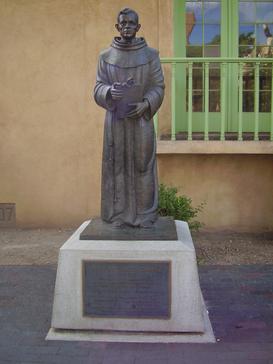
Angelico Chavez, O.F.M., was a Hispanic American Friar Minor, priest, historian, author, poet and painter. "Angelico" was his pen name; he also dropped the accent marks from this name.

Taos Plaza is a center of shops and monuments within the Taos Downtown Historic District in Taos, New Mexico.
The Río Arriba Rebellion, also known as the Chimayó Rebellion, was an 1837 Pueblo-Hispano popular revolt in New Mexico which succeeded in briefly placing José María González and Pablo Montoya as governor of Mexico's Santa Fe de Nuevo México territory. González and Montoya were both Taos Pueblo Indians and led the independent Junta Popular or Cantón, which was the most ethnically inclusive government in the history of New Mexico. They remain the only Pueblo governors of New Mexico to this day.
The history of New Mexico is based on archaeological evidence, attesting to the varying cultures of humans occupying the area of New Mexico since approximately 9200 BCE, and written records. The earliest peoples had migrated from northern areas of North America after leaving Siberia via the Bering Land Bridge. Artifacts and architecture demonstrate ancient complex cultures in this region.
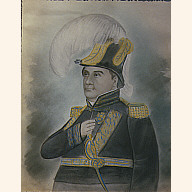
Manuel Armijo was a New Mexican soldier and statesman who served three times as governor of New Mexico between 1827 and 1846. He was instrumental in putting down the Revolt of 1837; he led the military forces that captured the invaders of the Texan Santa Fe Expedition; and he later surrendered to the United States in the Mexican–American War, leading to the capture of Santa Fe and occupation of New Mexico by the American army. Armijo attempted to expand Hispanic settlements and bolster the security of New Mexico by granting large acreages of land to prominent individuals. Armijo has been vilified by Americans participating in the conquest of New Mexico and some subsequent historians.

Diego de Vargas Zapata y Luján Ponce de León y Contreras (1643–1704), commonly known as Don Diego de Vargas, was a Spanish Governor of the New Spain territory of Santa Fe de Nuevo México. He was the title-holder in 1690–1695, and effective governor in 1692–1696 and 1703–1704. He is known for leading the reconquest of the territory in 1692 following the Pueblo Revolt of 1680. This reconquest is commemorated annually during the Fiestas de Santa Fe in the city of Santa Fe.

KABG is a commercial radio station licensed to Los Alamos, New Mexico, and serving the Santa Fe and Albuquerque radio markets. It is owned by American General Media and airs a classic hits radio format, playing Top 40 hits mostly from the late 1970s to the early 1990s. The radio studios and offices are located in Northeast Albuquerque.

The Santa Fe Plaza is a National Historic Landmark in downtown Santa Fe, New Mexico in the style of traditional Spanish-American colonial cities. The plaza, or city square is a gathering place for locals and also a tourist attraction. It is home to annual events including Fiestas de Santa Fe, the Spanish Market, the Santa Fe Bandstand, and the Santa Fe Indian Market.

Santa Fe is the capital of the U.S. state of New Mexico, and the county seat of Santa Fe County. With over 89,000 residents, Santa Fe is the fourth-most populous city in the state, and part of the Albuquerque–Santa Fe–Los Alamos combined statistical area, which had a population of 1,162,523 in 2020. Situated at the foothills of the Sangre de Cristo Mountains, the city is at the highest altitude of any U.S. state capital, with an elevation of 6,998 feet.

The Santiago E. Campos United States Courthouse is a historic courthouse building located at Santa Fe in Santa Fe County, New Mexico. Formerly designated simply as the United States Courthouse, it was renamed for the late District Judge Santiago E. Campos in 2004.

The Mormon Battalion Monument is a historic obelisk in rural Sandoval County, New Mexico. It was built in honor of members of the Church of Jesus Christ of Latter-day Saints who served in the United States Army's Mormon Battalion during the Mexican–American War of 1846–1848. It was built in 1940, removed in 1982, and rebuilt in 1996.
This is a list of protests in New Mexico related to the murder of George Floyd.

An equestrian statue of Juan de Oñate formerly stood in Alcalde, New Mexico, in the United States. Installed as part of a project to honor Hispanic culture, the monument was removed in June 2020 amid the George Floyd protests. It was situated outside the Northern Rio Grande National Heritage Center in Alcalde, New Mexico from 1994 to 2020.

A statue of Diego de Vargas made by Donna Quasthoff was installed in 2007 at the west end of Santa Fe, New Mexico's Cathedral Park, in the United States. The statue was removed in June 2020 for conservation concerns, and is now on display at the New Mexico History Museum.
The following is a timeline of the history of the city of Santa Fe, New Mexico, US.




